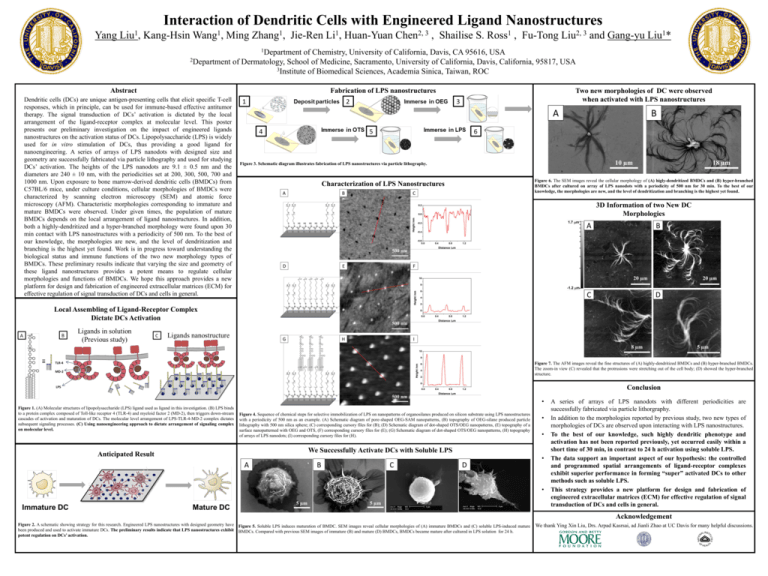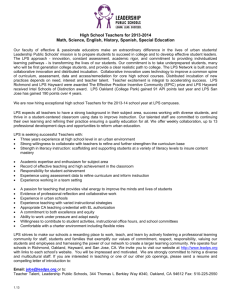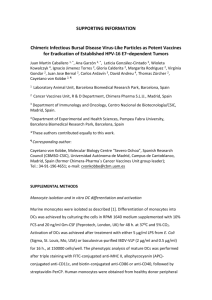PowerPoint **** - UC Davis Department of Chemistry
advertisement

Interaction of Dendritic Cells with Engineered Ligand Nanostructures Yang 1 Liu , Kang-Hsin 1 Wang , Ming 1 Zhang , Jie-Ren 1 Li , Huan-Yuan 2, 3 Chen , Shailise S. 1 Ross , Fu-Tong 2, 3 Liu and Gang-yu 1 Liu * 1Department of Chemistry, University of California, Davis, CA 95616, USA 2Department of Dermatology, School of Medicine, Sacramento, University of California, Davis, California, 95817, USA 3Institute of Biomedical Sciences, Academia Sinica, Taiwan, ROC Abstract Dendritic cells (DCs) are unique antigen-presenting cells that elicit specific T-cell responses, which in principle, can be used for immune-based effective antitumor therapy. The signal transduction of DCs’ activation is dictated by the local arrangement of the ligand-receptor complex at molecular level. This poster presents our preliminary investigation on the impact of engineered ligands nanostructures on the activation status of DCs. Lipopolysaccharide (LPS) is widely used for in vitro stimulation of DCs, thus providing a good ligand for nanoengineering. A series of arrays of LPS nanodots with designed size and geometry are successfully fabricated via particle lithography and used for studying DCs’ activation. The heights of the LPS nanodots are 9.1 ± 0.5 nm and the diameters are 240 ± 10 nm, with the periodicities set at 200, 300, 500, 700 and 1000 nm. Upon exposure to bone marrow-derived dendritic cells (BMDCs) from C57BL/6 mice, under culture conditions, cellular morphologies of BMDCs were characterized by scanning electron microscopy (SEM) and atomic force microscopy (AFM). Characteristic morphologies corresponding to immature and mature BMDCs were observed. Under given times, the population of mature BMDCs depends on the local arrangement of ligand nanostructures. In addition, both a highly-dendritized and a hyper-branched morphology were found upon 30 min contact with LPS nanostructures with a periodicity of 500 nm. To the best of our knowledge, the morphologies are new, and the level of dendritization and branching is the highest yet found. Work is in progress toward understanding the biological status and immune functions of the two new morphology types of BMDCs. These preliminary results indicate that varying the size and geometry of these ligand nanostructures provides a potent means to regulate cellular morphologies and functions of BMDCs. We hope this approach provides a new platform for design and fabrication of engineered extracellular matrices (ECM) for effective regulation of signal transduction of DCs and cells in general. Fabrication of LPS nanostructures Two new morphologies of DC were observed when activated with LPS nanostructures Figure 3. Schematic diagram illustrates fabrication of LPS nanostructures via particle lithography. Characterization of LPS Nanostructures Figure 6. The SEM images reveal the cellular morphology of (A) higly-dendritized BMDCs and (B) hyper-branched BMDCs after cultured on array of LPS nanodots with a periodicity of 500 nm for 30 min. To the best of our knowledge, the morphologies are new, and the level of dendritization and branching is the highest yet found. 3D Information of two New DC Morphologies Local Assembling of Ligand-Receptor Complex Dictate DCs Activation Figure 7. The AFM images reveal the fine structures of (A) highly-dendritized BMDCs and (B) hyper-branched BMDCs. The zoom-in view (C) revealed that the protrusions were stretching out of the cell body; (D) showed the hyper-branched structure. Conclusion • Figure 1. (A) Molecular structures of lipopolysaccharide (LPS) ligand used as ligand in this investigation. (B) LPS binds to a protein complex composed of Toll-like receptor 4 (TLR-4) and myeloid factor 2 (MD-2), then triggers down-stream cascades of activation and maturation of DCs. The molecular level arrangement of LPS-TLR-4-MD-2 complex dictates subsequent signaling processes. (C) Using nanoengineering approach to dictate arrangement of signaling complex on molecular level. Anticipated Result Figure 4. Sequence of chemical steps for selective immobilization of LPS on nanopatterns of organosilanes produced on silicon substrate using LPS nanostructures with a periodicity of 500 nm as an example. (A) Schematic diagram of pore-shaped OEG-SAM nanopatterns, (B) topography of OEG-silane produced particle lithography with 500 nm silica sphere; (C) corresponding cursory files for (B); (D) Schematic diagram of dot-shaped OTS/OEG nanopatterns, (E) topography of a surface nanopatterned with OEG and OTS, (F) corresponding cursory files for (E); (G) Schematic diagram of dot-shaped OTS/OEG nanopatterns, (H) topography of arrays of LPS nanodots; (I) corresponding cursory files for (H). • • We Successfully Activate DCs with Soluble LPS • • A series of arrays of LPS nanodots with different periodicities are successfully fabricated via particle lithorgraphy. In addition to the morphologies reported by previous study, two new types of morphologies of DCs are observed upon interacting with LPS nanostructures. To the best of our knowledge, such highly dendritic phenotype and activation has not been reported previously, yet occurred easily within a short time of 30 min, in contrast to 24 h activation using soluble LPS. The data support an important aspect of our hypothesis: the controlled and programmed spatial arrangements of ligand-receptor complexes exhibit superior performance in forming “super” activated DCs to other methods such as soluble LPS. This strategy provides a new platform for design and fabrication of engineered extracellular matrices (ECM) for effective regulation of signal transduction of DCs and cells in general. Acknowledgement Figure 2. A schematic showing strategy for this research. Engineered LPS nanostructures with designed geometry have been produced and used to activate immature DCs. The preliminary results indicate that LPS nanostructures exhibit potent regulation on DCs’ activation. Figure 5. Soluble LPS induces maturation of BMDC. SEM images reveal cellular morphologies of (A) immature BMDCs and (C) soluble LPS-induced mature BMDCs. Compared with previous SEM images of immature (B) and mature (D) BMDCs, BMDCs became mature after cultured in LPS solution for 24 h. We thank Ying Xin Liu, Drs. Arpad Kasrsai, ad Jianli Zhao at UC Davis for many helpful discussions.






